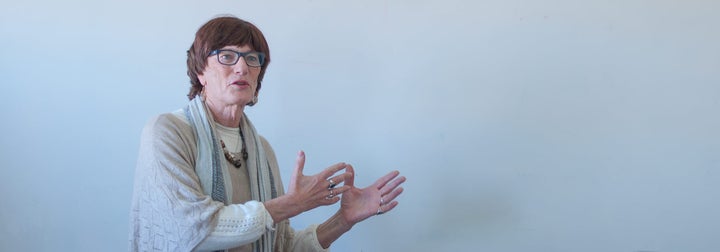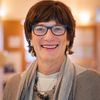
On my 50th birthday I woke up to the loneliest, most disconnected and painful day of my life. I had no more energy to continue breathing air into someone else’s body while I myself was becoming lifeless.
That day I made the monumental decision to begin my gender transition journey.
After decades of struggle, my physical body would finally align with my thoughts and feelings ― with what I’ve always known to be my true gender. But despite this, after that transition, I still didn’t feel whole.
Gender identity dysphoria accompanied me at birth 68 years ago, severely impacting most of my life. I was born on Long Island as Jeffrey Scott Smith, but I never felt right putting breath into what I felt was someone else’s body, as if I was held captive in it.
As far back as 5 years old, I always felt as if I was running ― not sure whether I was running to myself or away from myself, but I always had the sensation that I was running.
In 1971, at 20 years old, I ran to Israel. I wanted to work on a kibbutz: the ideal communal life, a place where the “we” is more important than the “me” ― a place where maybe I could forget about my daily internal struggles for authenticity and truth.
During my time in Jerusalem, I visited the ancient Western Wall. As I approached the wall, I did not realize that this visit would be life-changing.
As I arrived, excited to touch the stones, I quickly became distressed, realizing I had to choose which side to approach it from — separated by gender — a decision indicative of the challenge I was painfully struggling with my entire life, my daily chronic anxiety. I felt a daunting pressure to finally choose: Am I male or female? What do I do? I felt such inner turmoil.
I said to myself: If I choose to enter on the women’s side, where I know I belong, I will cause unwanted attention. If I choose to enter on the side that the world dictates to me, I will experience feelings of self-betrayal.
I felt completely torn by the demands the world put on my decision ― and the demands my inner truth did as well.
But I intuitively sensed in quite a gnawing way that the stones were pulling me to touch them.
So with mixed emotions, I entered on the men’s side ― excited, but despising myself once again for not being authentic about who I really was, particularly in such a holy place.
“Something changed within me, as if a shift of sorts occurred. Not too many years later, I realized that what I sensed at that time, for the first time in my life, was my soul ― my spiritual center.”
On that hot summer day, as I rested my aching head against the cool stones, I felt embraced. I felt something within me other than pain. Something changed within me, as if a shift of sorts occurred. Not too many years later, I realized that what I sensed at that time, for the first time in my life, was my soul ― my spiritual center.
As I walked away from the wall, I was excited to be Jewish, as never before. I was sure that I wanted to experience more of my Jewish identity and learn more about Israel. But just like at the wall, I struggled because I didn’t know where I fit. Through which gate do I enter?
By 1975, in New York, I became immersed in the Jewish Orthodox religious world, being referred to by my Hebrew name Yaakov, and making deals with G-d. I’d say, “G-d, I will be observant and devout, and maybe in return You will release me from the demons that are haunting me. Help me feel that I am no longer a woman or change my body so it is no longer that of a man.”
But nothing changed.
Maybe G-d is waiting for me to try harder, I thought. So, out of desperation, I did.
In 1985, with my wife and children, I moved to Israel and began living completely as an ultra-Orthodox man, becoming the director of the Chabad House in the Old City of Jerusalem. And I succeeded, but the more I succeeded, the more I felt like an impostor.
In 1991, after 20 years of trying my best to live someone else’s life, I had only succeeded in feeling like a fraud. In Israel, I was home and, yet, there was no place for me to be at home. I knew I could not continue that life.
After a painful divorce, I left traditional Judaism, returned to New York and assumed my prior name, Jeff. Lonely and alone, I asked myself, How can I be authentic in a world that really doesn’t encourage me, and actually makes it so difficult?
After 10 years of spiraling down a dark hole, I made the most important ― and most freeing ― decision of my life.
It had to be made. It saved my life. In a flash, my dark lonely life became illuminated with the awareness that the time had arrived to begin living my truth!
Now I simply cried out, “G-d, please help me.” And He did!

To me, authentic living meant no longer living in fear, with the shame and guilt that accompanied my life of infidelity to myself and enslavement to others’ expectations of how I should live my life.
Authentic living granted me freedom and a sense of self-worth, as I became faithful to my own essence ― my soul. I no longer look left and right seeking permission and agreement from others on how I chose to live my life.
My journey was as much, if not more, spiritual and healing as it was a gender transition. I began to feel quiet inside, full of harmony and gratitude. More importantly, I began to feel “a part of the world” rather than “apart from the world.” There are no words to express the gratitude and peace of mind that this brought me.
Along my gender transition journey, I legally changed my name to Jessica. And yet, I still was not whole. There was a hole in my life where traditional Judaism previously resided. I longed to return to traditional Jewish living and to Israel, always knowing since my first visit in 1971 that Israel is my home. However, now, I was ready to return in truth, as a woman. This resulted in the next step of my personal journey as I continued from Jessica to the Hebrew equivalent, Yiscah.
And then, on my 60th birthday in 2011, the day came to return home to Jerusalem, where the journey began.
Again I approached the Western Wall ― not as Jeff in the men’s section, but, for the first time, as Yiscah in the women’s section.
The journey to my truth was complete but I realized that now it was time to help others with theirs.
Today, as Yiscah, while I consider myself to be post-denominational, I am an observant woman who has discovered spiritual and emotional healing. I returned home to Israel, returned to Torah and to my own spiritual center. This has enabled my authentic intimate encounter with the Divine within me to manifest. Finally, I feel whole.
Today, I teach authentic Jewish spiritual practice at the Pardes Institute in Jerusalem and in my home and I am a proud and unapologetic public speaker who connects with audiences around the world.
My personal journey significantly influences my learning and teaching of Jewish spiritual texts. Before, I was not at home with myself. I went from estranged and disconnected to finally dwelling in my own inner sanctuary ― a home punctuated with gratitude and wonder that I share with others.
“If done on a large scale, authentic living can strengthen communities, as people are better able to weather the ups and downs in life and are better equipped to support each other because they possess the understanding and contentment of who they are — and what their ultimate purpose is.”
My teachings, based in traditional spiritual Jewish texts and integrated with my own, ongoing life story, bring inspiration, healing and encouragement to many more people than I ever imagined possible.
Helping others encounter a deeper part of themselves, the Divine spark within them and the foundation for true and sustainable authentic living is why I do what I do.
I share the teachings of Rabbi Kalonymus Kalman Shapira, widely known as the Piaseczna Rebbe, who was one of the great Polish Hassidic masters of the 20th century.
The Piaseczna emphasizes how important it is to gaze, observe and explore your inner being with curiosity, rather than with judgment. In this way, you will become more aware of your inner self, your spiritual center and your soul. This perspective is what helped me to celebrate and honor my real self.
In my interactions with students, I see that each person possesses the inner resources so important to connect the head and the heart — and discover their true selves.
Authentic Jewish living, premised on spiritual study and practice, is a powerful way one can accomplish this. If done on a large scale, authentic living can strengthen communities, as people are better able to weather the ups and downs in life and are better equipped to support each other because they possess the understanding and contentment of who they are ― and what their ultimate purpose is.
My long, deep journey to find my authentic self and live my truth brought me to where I am today. This peaceful, joyful life where I am able to share my journey ― and the tools that helped free me to live authentically ― is the truest gift in the world. I hope that my teachings, my journey and my encouragement can help others live as their authentic spiritual selves with joy, compassion and gratitude.
Yiscah Smith is the author of Forty Years in the Wilderness: My Journey to Authentic Living. A documentary on her life, “I Was Not Born a Mistake,” premieres in Israel this fall (Haifa in October, Jerusalem in December) and in the U.S. early next year at the New York Jewish Film Festival. She lives in Jerusalem and teaches at the Pardes Institute of Jewish Studies and in her home in Jerusalem. She also is available to be a keynote speaker at spiritually related conferences and retreats, both Jewish and non-Jewish.
